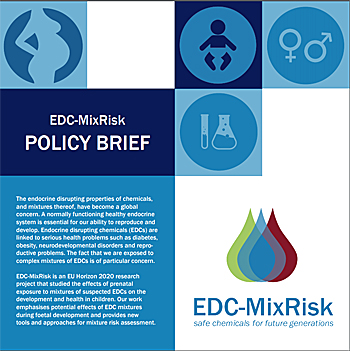 |
|
Health Risks Associated With Mixtures Of Human-Made Chemicals Are Underestimated A project focusing on the effects of mixtures of endocrine-disrupting chemicals on children – EDC-MixRisk with the ultimate aim of promoting safer use of chemicals, issued their press release last month to alert the public and policy makers across the world to the human health risks of chemicals in our environment, in our food, and in our clothing. The endocrine disrupting properties of chemicals, and mixtures thereof, have become a global concern. A normally functioning healthy endocrine system is essential for our ability to reproduce and develop. Endocrine disrupting chemicals (EDCs) are linked to serious health problems such as diabetes, obesity, neurodevelopmental disorders and reproductive problems. The fact that we are exposed to complex mixtures of EDCs is of particular concern. Endocrine disrupting chemicals (EDCs) show associations to some of the most common chronic diseases and disorders of the western world.Current risk assessment and management practices, however, focus mainly on exposure to single substances. Exposure to hazardous substances, especially endocrine disrupting chemicals (EDCs), during the foetal period is of particular concern, as it can lead to irreversible changes in the development of organs and tissues and increased susceptibility to diseases later in life. The press release below, warns us that we are exposed to a large number of man-made chemicals, creating combinations of chemical mixtures, to which we are exposed during our whole lifespan. The EU Horizon 2020 *EDC-MixRisk project (https://edcmixrisk.ki.se/), which has now reached its conclusion, was initiated to investigate how effects caused by real-life relevant mixtures could be studied. The project, composed by researchers from several Swedish, European and one U.S. university, developed a novel approach based on identifying and testing EDC mixtures associated with adverse health outcomes in humans. The workshop is organized jointly with the EuroMix project, highlighting the main results and conclusions from the two H2020-funded projects, EDC-MixRisk and EuroMix, and their implications for future needs for chemical mixture risk assessment. * The full name of the organisation is: “Integrating Epidemiology and Experimental Biology to Improve Risk Assessment of Exposure to Mixtures of Endocrine Disruptive Compounds — EDC-MixRisk” The Policy Brief can be downloaded from the Unionsafety E-Library Database by clicking on the pic above or by clicking on the link and using search words 'Chemical Cocktail' Further information and why EDCs matter to our health: https://edcmixrisk.ki.se/why-edcs-matter/ Source: EDC-MixRisk
|
|
|
 By using epidemiology data from the Swedish pregnancy cohort SELMA (a cohort of more than 2300 pregnant women), reference mixtures were created to mimic real life exposures (at concentrations found in the pregnant women).
By using epidemiology data from the Swedish pregnancy cohort SELMA (a cohort of more than 2300 pregnant women), reference mixtures were created to mimic real life exposures (at concentrations found in the pregnant women).